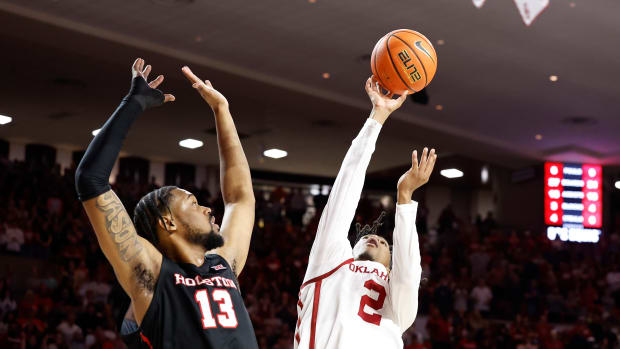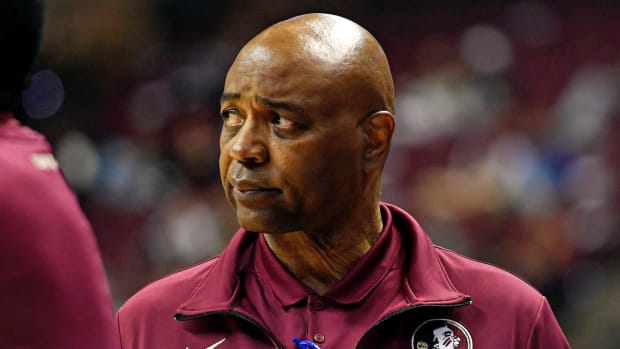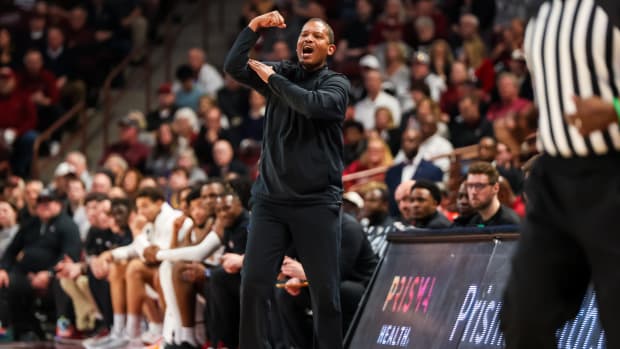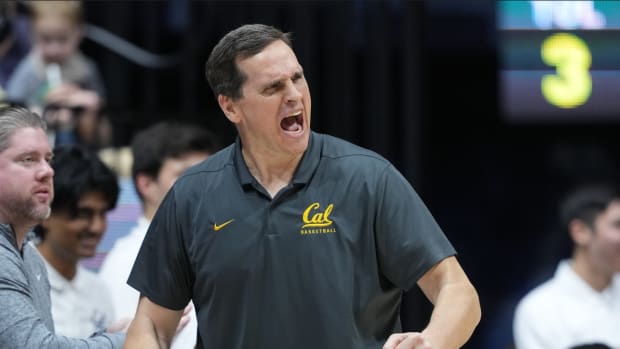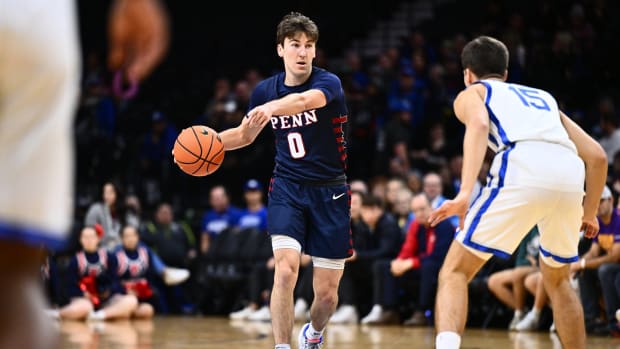How NIL Deals Could Keep the Door Open for HBCUs to Land Top Recruits
To hear Nick Saban tell it, historically Black colleges and universities (HBCUs) are thriving in the NIL era by shelling out million-dollar paydays to the country’s top athletes and closing the talent gap between Power 5s and mid-majors in one fell swoop.
“I don’t even make a million!” Jackson State football coach Deion Sanders tweeted in response to Saban’s unsubstantiated claim that Sanders paid Travis Hunter, the No. 1 prospect in the SI99 recruiting rankings, the inordinate amount.
Saban’s knee-jerk reaction is part sour grapes and likely, part shock; Hunter is the first five-star football recruit to pick an HBCU in the modern recruiting era. This comes two years after Makur Maker became the first five-star basketball recruit to pick an HBCU when he committed to Howard in 2020.
There was an uptick in HBCU interest among elite prospects after the killing of George Floyd in 2020, as an abundance of Black Lives Matter protests and marches brought out countless world leaders, celebrities and athletes to speak against racism, inequality and police brutality.
The country’s top Black prospects, who make up the vast majority of the SI99 recruiting rankings, were trading in their customary social media posts announcing offers from college basketball heavyweights like Kansas, Kentucky, North Carolina and Duke to shoutout offers from HBCU like Howard, Hampton and North Carolina A&T.
Maker committed to Howard two months after Floyd’s murder and said his goal was “to make the HBCU movement real so that others will follow.”
The united front reignited longstanding “what if” backchannel barbershop conversations about young Black stars teaming up at an HBCU and pulling off the unthinkable in March.
“That’s definitely been something that’s been talked about for decades,” Howard coach Kenny Blakeney says. “NBA stars have been saying ‘what if’ for a long time. The interest has always been there from top prospects.”
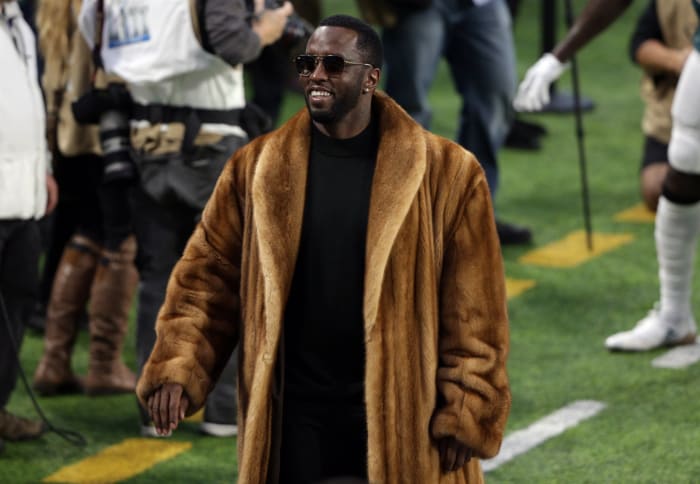
Diddy, a Howard alum, could craft NIL deals to send top prospects to Washington, D.C.
Brad Rempel-USA TODAY Sports
In 2009, John Wall, the No. 1 prospect in the country at the time, took an unofficial visit to North Carolina Central. Wall and NCCU coach LeVelle Moton grew up in the same neighborhood in Raleigh, and Wall refers to Moton as “unc,” short for uncle, “til this day.”
Still, in the end, Wall went on to commit to Kentucky, and a year later he went No. 1 in the NBA draft to the Wizards.
“It sounds great, but, I’ll just be honest, most of us don’t want to gamble with our career,” says Omaha Biliew, an elite 2023 wing who is down to Iowa State, Kansas, Oregon and the NBA G League. “We know that if we go to certain Power 5 schools that we’ll be seen all the time, we’ll play against the best, we’ll play in March, all of that. We just haven’t seen it work out for someone at an HBCU. It’s gonna take some guys to jump out there and set it off.”
While interest in HBCUs isn’t a new phenomenon among elite prospects, to further Biliew’s point, a lack of resources has been the culprit keeping both athletes from committing and HBCU coaches from applying the full-court recruiting press on top prospects.
“A lot of the kids that are getting those big NIL deals are kids that we’re not gonna get anyway,” Norfolk State coach Robert Jones says.
NBA Hall of Famer Chris Webber famously criticized HBCUs in the book Forty Million Dollar Slaves, which highlights subpar facilities and a lack of TV deals.
“A lot of people put that pressure on me to go to an HBCU, like ‘Come on, Chris, you can change it around, you can change it around,’” Webber writes in the book. “Playing on BET is not good enough for me. I want the world to see. In a way, I feel guilty because we could have changed that rhyme. But we had to do what was best for us at that time. But we talked a lot about going to Black colleges.”
It certainly can’t help the cause that federal funding for HBCUs has been in a free fall for nearly 20 years. The American Council on Education found that from 2003 to ’15 funding for private HBCUs declined by 42%. In ’18, the Government Accountability Office found that public HBCUs had deferred maintenance backlogs of $67 million.
On the bright side, the White House in March announced more than $2.7 billion in funding for HBCUs through the American Rescue Plan.
“NIL is pulling the curtain back,” Moton says. “A lot of those coaches’ biggest fears are coming to fruition because for so long they’ve convinced the world that they’re the James Naismith Jr. of basketball. The reality is, name the top two or three coaches in college football and basketball and they all benefited mostly from players that look like me. They know that. It just takes one guy to step out there and usher in the new wave, and then another will follow and then another.”
The operative question is, with NIL in play as potentially the ultimate equalizer, could deep-pocketed HBCU boosters sweeten the pot enough to lure more stars?
Per new NCAA guidelines, boosters are free to enter into NIL agreements with prospects—provided they operate independent of the university and its athletic department. They are not permitted to push contracts to persuade prospects to enroll.
In the same way that Miami alum John Ruiz, a billionaire entrepreneur and lawyer, has signed more than 100 active athletes to marketing deals through his companies, rich and famous HBCU alums like Nick Cannon and Diddy, who both attended Howard, could craft a hefty NIL deal through one of their many companies or Oprah Winfrey, a graduate of Tennessee State, could have a top prospect sign on with Weight Watchers through NIL.
If said prospect somehow happened to consider their alma mater his new dream school, it's merely the icing on the cake.
“Oh man, you’d have to take Oprah’s call!” Biliew says. “I mean that’s Oprah!”
Most big NIL news comes out just after a player signs on with a school, meaning the legwork is often done beforehand and behind the scenes.
When Kansas State transfer Nijel Pack committed to Miami on April 23, Ruiz tweeted: “The biggest LifeWallet deal to date, two years $800,000.00 total at $400,000.00 per year plus a car. Congratulations!!!”
As Jones points out, “There are a lot of powerful alumni at HBCUs, what it boils down to is if they feel like athletics is that important?”
The answer to that million-dollar question could run up an identical tab in NIL money.
Jones isn’t confident about that possibility coming to fruition soon, but he says in order to change the game via NIL, “the mindset has to change” among VIP alumni.
“A lot of HBCU alumni don’t quite see the importance of sports like Power 5 alumni do,” Jones says. “For example, they don’t fully understand the potential return on the investment for a successful basketball team playing in March.”
At Norfolk State, donors sit at the highest tier for $25,000 contributions, a small price to pay for the $1.6 million payday Jones and the Spartans earned after winning the play-in game before falling in the first round in the 2021 NCAA men’s basketball tournament.
Howard recently struck a deal with Jordan Brand to outfit its athletics teams for their upcoming seasons.
“There’s no doubt about it, the NIL could be the ultimate equalizer,” Blakeney says. “To know that you have some alums like [Diddy] that love this university, what a great picture and vision that could be. That’s just how things work in the NIL space.”
The potential downside of NIL for HBCUs, at least at this stage, is the ability for high-major schools to swipe their best players, who could play immediately using the NCAA’s new one-time transfer waiver.
“It’s rich guys chasing pretty girls, and the Power 5’s are the rich guys,” Moton says. “That’s where NIL hurts us. If we’ve got a freshman that comes in and produces and doesn’t have a solid foundation but has desires to play at a high level, which they all do, he’s gone. Let’s be honest, most schools are being lazy and recruiting off the rosters of low to mid-major schools. I think seeing a NIL deal with an HBCU and a five-star prospect could begin a trend.”
Jones isn’t holding his breath; he’s more focused on securing what he deems to be “more realistic” options as it pertains to NIL.
“Don’t let all the headlines fool you. Outside of those Power 5 schools, the NIL deals are really small,” Jones says. “So, if we can compete through NIL and beat out a Conference USA school for a kid that, theoretically, we shouldn’t have is a strong start. But we’re not gonna do Oscar Tshiebwe $2 million numbers with NIL, it’s hard enough raising money alone at HBCUs. I’m a realist; those deals aren’t gonna happen for us right away … maybe never. But on a smaller scale, we could win with NIL. Just have to shift the mindsets of the alumni base.”
More CBB Coverage:

